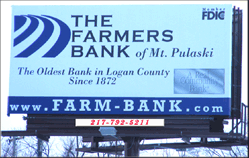 The first reason is that because of continuous rains in the
spring, beans and corn were planted very late, some as late as
May 15 (significant because that was the plant date for corn
back when it was grandpa's farm).
Late planting pushes back the harvest date. The first reason is that because of continuous rains in the
spring, beans and corn were planted very late, some as late as
May 15 (significant because that was the plant date for corn
back when it was grandpa's farm).
Late planting pushes back the harvest date.The second reason
that such large contingents of the crops are still in the field
is that the corn crop is coming in very wet, with harvested
moisture above 20, and producers are taking this extra bit of
time before the first major frost to dry the corn down in the
field. Corn with lower moisture levels presented at the elevator
means the producer will pay less for expensive drying processes.

And the third reason the crops are still in the field is that
the prices for corn and beans right now are lower than desired,
and lower than they have historically been for the last couple
of years, and the size of the bean crop is variably less than
hoped for. Since prices are low and the size of each bean is
less than desired, why hurry to get it to market.
The corn crop across the nation is good to excellent,
translating into lower prices for all the producers. Together
with higher input prices, this means that the producer will have
a much lower net profit per acre since 2007. Added costs at the
point of sale, such as higher drying costs and the cost of
testing for quality issues such as aflatoxin, further erode the
profit per acre (see the introduction by John Fulton).
The only hedge farmers have against lower immediate prices at
harvest is to either put a portion of their crop in on-farm
storage at an additional expense, or put a portion into storage
at the elevator -- again, an added expense.

2011 was the great change year for the price of corn. The
average sale price for corn prior to 2011 fell short of the $4
mark, with 2010 averaging $3.83. The average price in 2011
jumped to $6.01 nationally, and higher regionally, an increase
of almost 64 percent. Perhaps this jump in prices was due to the
optimism of increasing local markets for corn with the expansion
of ethanol production and the federal stimulus for ethanol
production. This jump in prices continued in 2012 to an average
of $6.67 due to the drought-related shortfall of the Midwestern
crop.
One of the possible dilemmas for producers is related to the
development of drought-tolerant corn. Drought-tolerant corn is
the result of selecting varieties of seed that showed better
characteristics of performance, particularly valuable during
drought conditions.
Then the expected glut of corn in 2013 and the failed
expansion of local markets pushed average pricing back down
below the 2011 mark.
Any increase in cost and decrease in price shrinks the
on-farm profit and the amount of money available in farming
regions for ag-related products.
Drought conditions in both 2012 and 2013 should have dried
corn down to lower moisture levels by the expected harvest
dates, but in both years, producers found that their test
harvests brought in corn with moisture levels much higher than
expected.
This year's initial spot tests in the third week in September
brought in corn testing at 23 percent, a level that was rejected
at some elevators, causing the corn harvest to be pushed back.
Since the killer frost has not yet hit in earnest in Logan
County, producers put the corn harvest on hold to allow for
further drying and instead began to harvest beans. The soybean
crop was variable since the rains crucial to bean production
during the last two weeks of production were almost nonexistent.
Beans began to dry earlier than expected in the fields, and the
size of the crop was less than hoped for in many areas.
Corn harvested three weeks later, in the middle of October,
showed that the crop had dried down only about 2 percent, to 21.
Killer frosts continue to be delayed (a killer frost prevents the
further drying of corn in the fields because the tissues in the corn
plant for moving moisture are damaged or destroyed), and strips of
corn in the fields continue to stay green.
[to top of second column]
 |
 A possible explanation for this apparent failure to dry in the
fields is that the very same characteristics that make
drought-tolerant corn excellent during drought years also cause the
plant and, more important, the kernels to hold on to moisture and
dry more slowly. The result is added cost to dry the harvested corn.
Altogether, higher input costs and lower sale prices translate to
lower profits per acre for the producer.
A contingent of Logan County farmers got together in 2005 in an
attempt to increase the local market for corn with the development
of an ethanol plant in the county. A local ethanol production
facility would give local producers another outlet for their corn
crop and would likely increase the profit margin for participating
farmers. This valiant effort to increase profits came to a
screeching halt late in 2011, mostly due to the protests by Logan
County residents who resisted locating the ethanol plant in their
"backyards," followed by the shrinking federal ethanol subsidy,
making the success of the ethanol production facility doubtful.

This failure to locate a local competing outlet for the corn crop
left Logan County producers at the mercy of the Chicago market and
large-scale buyers, ADM and Cargill.
Input costs are likely to continue to climb as new challenges are
presented to producers. Production will follow the weather and
climate trends, sometimes making Logan County producers the winners
in the competition to grow a larger-than-usual crop when producers
in other regions fall below their norm, and sometimes making Logan
County producers the losers in the production competition. Costs at
the point of sale will likely continue to rise as new legislation
calls for more testing for safety and further restricts the sale of
damaged corn.
These and other challenges have made the selling price and costs
to market a game changer.

Perhaps the most adequate answer is another attempt to develop
more diverse and local markets for corn and beans, or diversify the
crop with specialty food crops to local markets.
Either way, being a producer today is a very challenging job.
[By JIM YOUNGQUIST]

|